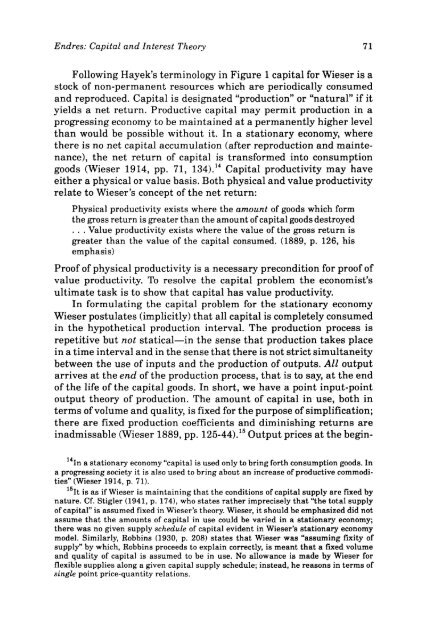Review of Austrian Economics - The Ludwig von Mises Institute
Review of Austrian Economics - The Ludwig von Mises Institute
Review of Austrian Economics - The Ludwig von Mises Institute
You also want an ePaper? Increase the reach of your titles
YUMPU automatically turns print PDFs into web optimized ePapers that Google loves.
Endres: Capital and Interest <strong>The</strong>ory 71<br />
Following Hayek's terminology in Figure 1 capital for Wieser is a<br />
stock <strong>of</strong> non-permanent resources which are periodically consumed<br />
and reproduced. Capital is designated "production" or "natural" if it<br />
yields a net return. Productive capital may permit production in a<br />
progressing economy to be maintained at a permanently higher level<br />
than would be possible without it. In a stationary economy, where<br />
there is no net capital accumulation (after reproduction and maintenance),<br />
the net return <strong>of</strong> capital is transformed into consumption<br />
goods (Wieser 1914, pp. 71, 134). 14 Capital productivity may have<br />
either a physical or value basis. Both physical and value productivity<br />
relate to Wieser's concept <strong>of</strong> the net return:<br />
Physical productivity exists where the amount <strong>of</strong> goods which form<br />
the gross return is greater than the amount <strong>of</strong> capital goods destroyed<br />
. . . Value productivity exists where the value <strong>of</strong> the gross return is<br />
greater than the value <strong>of</strong> the capital consumed. (1889, p. 126, his<br />
emphasis)<br />
Pro<strong>of</strong> <strong>of</strong> physical productivity is a necessary precondition for pro<strong>of</strong> <strong>of</strong><br />
value productivity. To resolve the capital problem the economist's<br />
ultimate task is to show that capital has value productivity.<br />
In formulating the capital problem for the stationary economy<br />
Wieser postulates (implicitly) that all capital is completely consumed<br />
in the hypothetical production interval. <strong>The</strong> production process is<br />
repetitive but not statical—in the sense that production takes place<br />
in a time interval and in the sense that there is not strict simultaneity<br />
between the use <strong>of</strong> inputs and the production <strong>of</strong> outputs. All output<br />
arrives at the end <strong>of</strong> the production process, that is to say, at the end<br />
<strong>of</strong> the life <strong>of</strong> the capital goods. In short, we have a point input-point<br />
output theory <strong>of</strong> production. <strong>The</strong> amount <strong>of</strong> capital in use, both in<br />
terms <strong>of</strong> volume and quality, is fixed for the purpose <strong>of</strong> simplification;<br />
there are fixed production coefficients and diminishing returns are<br />
inadmissable (Wieser 1889, pp. 125-44). 15 Output prices at the begin-<br />
14 In a stationary economy "capital is used only to bring forth consumption goods. In<br />
a progressing society it is also used to bring about an increase <strong>of</strong> productive commodities"<br />
(Wieser 1914, p. 71).<br />
15 It is as if Wieser is maintaining that the conditions <strong>of</strong> capital supply are fixed by<br />
nature. Cf. Stigler (1941, p. 174), who states rather imprecisely that "the total supply<br />
<strong>of</strong> capital" is assumed fixed in Wieser's theory. Wieser, it should be emphasized did not<br />
assume that the amounts <strong>of</strong> capital in use could be varied in a stationary economy;<br />
there was no given supply schedule <strong>of</strong> capital evident in Wieser's stationary economy<br />
model. Similarly, Robbins (1930, p. 208) states that Wieser was "assuming fixity <strong>of</strong><br />
supply" by which, Robbins proceeds to explain correctly, is meant that a fixed volume<br />
and quality <strong>of</strong> capital is assumed to be in use. No allowance is made by Wieser for<br />
flexible supplies along a given capital supply schedule; instead, he reasons in terms <strong>of</strong><br />
single point price-quantity relations.

















